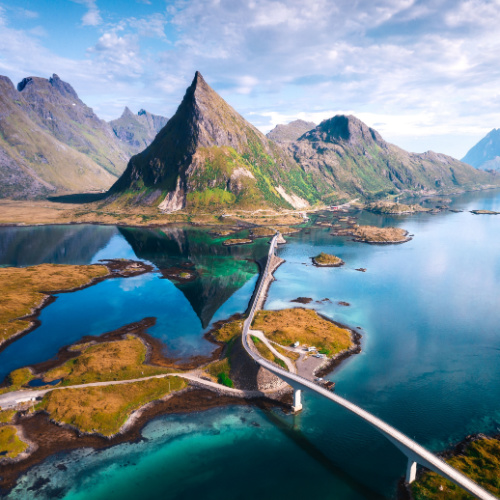
Lauri Lohi/Shutterstock
When Is the Best Time to Visit Norway?
The best time to visit Norway is during the shoulder seasons of spring (April to June) and autumn (September to October). During these months, the weather is generally mild and sunny, with fewer crowds and lower prices than during the peak summer season.
Here are some of the benefits of visiting Norway during the shoulder seasons:
- Mild weather: Norway has a temperate oceanic climate, with mild summers and cool winters. The shoulder seasons offer pleasant temperatures, making them ideal for sightseeing, exploring, and enjoying the outdoors.
- Smaller crowds: The shoulder seasons are less crowded than the peak summer season, so you’ll be able to enjoy Norway’s popular tourist attractions without having to deal with large crowds. This is especially important if you’re visiting popular destinations like the Geirangerfjord, the Lofoten Islands, and the Trolltunga viewpoint.
- Lower prices: Prices for flights, accommodation, and activities are generally lower during the shoulder seasons than during the peak summer season. This means you can save money on your trip without having to sacrifice quality.
Here are some specific examples of how you can enjoy the most of Norway during the shoulder seasons:
- Spring (April to June): The weather in spring is typically sunny and mild, with occasional showers. This is a great time to visit for hiking in the Jotunheimen National Park, visiting the Nærøyfjord, and seeing the midnight sun in the Arctic Circle.
- Autumn (September to October): The weather in autumn is also typically sunny and mild, with occasional showers. This is a great time to visit for seeing the fall foliage, visiting the Bergen fish market, and seeing the northern lights in the Arctic Circle.
While there are many great times to visit Norway, if you’re looking for the best weather and the most opportunities to enjoy the country’s outdoor activities, then we recommend visiting during the shoulder seasons of spring and autumn.
 Average Temperatures by Month
Average Temperatures by Month
|
Jan |
Feb |
Mar |
Apr |
May |
Jun |
Jul |
Aug |
Sep |
Oct |
Nov |
Dec |
| Fahrenheit |
27°
|
29°
|
35°
|
44°
|
54°
|
61°
|
64°
|
64°
|
56°
|
47°
|
37°
|
30°
|
| Celsius |
-3°
|
-2°
|
2°
|
7°
|
12°
|
16°
|
18°
|
18°
|
13°
|
8°
|
3°
|
-1°
|
Climate in Norway
Summer Season in Norway
Norwegian summers are mild and relatively short, especially in the coastal regions, with temperatures rarely exceeding 20°C (68°F). The northern parts experience the phenomenon of the Midnight Sun, providing long days for outdoor activities like hiking and fishing. Summers are characterized by their natural beauty, with lush landscapes and opportunities to explore the fjords and mountains under generally mild and pleasant conditions.
Rainy Season in Norway
Norway does not have a specific rainy season, but rainfall is more frequent during the summer and autumn months, especially along the western coast. The rain can vary from light showers to heavier downpours and contributes to the country's scenic beauty, including its numerous waterfalls and green landscapes.
Winter Season in Norway
Winters in Norway are long and cold, especially in the interior and northern regions, with temperatures often dropping below freezing. Snowfall is common, offering picturesque winter landscapes and making Norway a popular destination for skiing and other winter sports. The coastal areas experience milder winters but with more precipitation. Winter is also the best time to experience the Northern Lights, particularly in the Arctic Circle regions. Despite the harsh conditions, winter sports, and cultural activities like visiting museums and cozying up in traditional cabins, remain popular.
Our Recommendations
| Destination |
Jan |
Feb |
Mar |
Apr |
May |
Jun |
Jul |
Aug |
Sep |
Oct |
Nov |
Dec |
| Norway |
 |
 |
 |
 |
 |
 |
 |
 |
 |
 |
 |
 |






